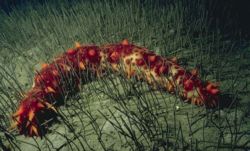
- Kingdom: Animalia
- Phylum: Echinodermata
- Class: Holothuroidea
Subclass Apodacea
- Apodida
- Molpadiida
Subclass Aspidochirotacea
- Aspidochirotida
- Elasipodida
Subclass Dendrochirotacea
- Dactylochirotida
- Dendrochirotida
| Sea cucumber |
|---|
 |
| Scientific Classification |
|
| Orders |
Subclass Apodacea
Subclass Aspidochirotacea
Subclass Dendrochirotacea
|
| Anatomy by BIODIDAC |
The sea cucumber is any of the species of marine invertebrates from assigned to the taxonomic class Holothuroidea. These echinoderms (spiny skinned) are found all over the world, mostly on the ocean floor. It has a "tube like" body, with a leathery type of skin. It earned its name because it looks like a cucumber. The sea cucumber has an endoskeleton (internal skeleton) beneath the skin. It feeds on debris usually found on the benthic layer ("the lowest level of a body of water, such as an ocean or a lake"). It also can eat plankton, or other amoebic substances. The sea cucumber has an incredible defense mechanism which it uses to ward off, or distract predators. As for food, it can be used in soups, stews, and braised dishes. The creature can also be used medically in creams, oils, or even cosmetics. [1]
The sea cucumber has a "tube like" body, with a leathery type of skin. Its named after what it resembles, a cucumber. It has an endoskeleton, beneath the skin, which helps to provide support. A sea cucumber has a very unique anatomy. It has a water vascular system, which aids in the moving process. Some are complete with tentacles that branch out from the front of the tube like body, and within the tentacles, lies the mouth of the creature. Along the sides of the tube-like leathery body, the sea cucumber has tube feet which aid in motility (mobility). Then, at the very end of the body, lies the anus, where the waste is disposed of. Some kinds of sea cucumber have unique organs not found in other organisms. On the inside of the creature, there are organs used for breathing, called respiration trees, which display Cuvierian tubules. These structures can come out the anus, and seem in most cases to be a method of defense. These tubules then can either trap predators, or deter them away from the sea cucumber. When they come out of the anus, they tend to become very sticky and expand into greater lengths. [2]
There are the two standard genders (male and female) of these creatures. Sea cucumbers reproduce sexually (outside of the body). The male will release large amounts of sperm into the water, while the female will release great quantities of eggs. There is usually a kind of "signal" that tells the creatures when this spawning should occur. These signs can include things such as, a plankton bloom, or certain water temperatures. The two will eventually meet, and the sperm will fertilize the egg, and a larvae will be created. The larvae are able to move through the water because of cilia. These baby sea cucumbers feed mostly on plankton that move through the water. Although, some females of different species are very unique, in that they can brood (to warm, cover, or protect) eggs that have already been fertilized. [3]
The sea cucumber can be found all over the world, mostly on the ocean floor. It is a natural scavenger, eating basically whatever it can find, which usually consists of debris found on the benthic layer ("the lowest level of a body of water, such as an ocean or a lake"). They also eat plankton and other amoebic (organic) substances found on the seafloor. They will often use their tentacles as a means to get food. As food flows through the ocean current, the sea cucumber will allow its tentacles to become like a net to catch these organisms. They also dig into the sand using their tentacles.
Sea cucumbers can be used for the purposes of food and medicine. Such countries as Japan, China, Malaysia, and Indonesia consider this unique animal to be a fine delicacy. Sea cucumbers must be processed in order to be eaten. This processing consists of drying, cleaning, and obviously packaging. The product is sold in a dehydrated form, and is then rehydrated by the consumer before it is cooked. Most people would find the "gelatinous" texture of the animal, to be dissatisfying or gross. Although, most people do not eat it in that manner, it is normally cooked in stews, soups, or braised dishes. Certain specimens of these creatures are known to be highly prized for their medicinal purposes, and some have been known to have amazing healing properties. These specimens have started entire pharmaceutical industries, based on certain extracts. People will use these extracts to create certain creams, oils, and even cosmetics. Sea cucumber extracts have been known to have such amazing "powers" as to help heal wounds faster, and even have less scarring.[4]Sea pig
(Scotoplanes globosa)
Order: Elasipodida
|
||||||||||||||||||||